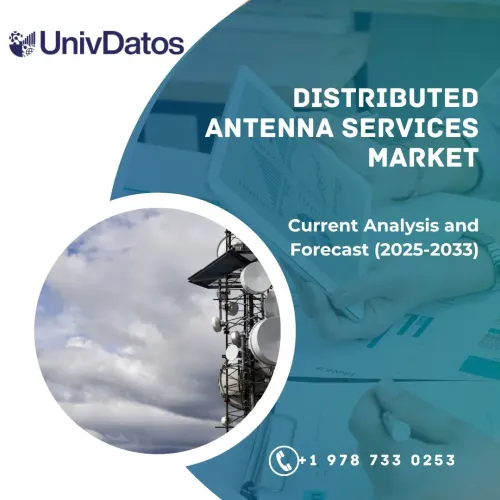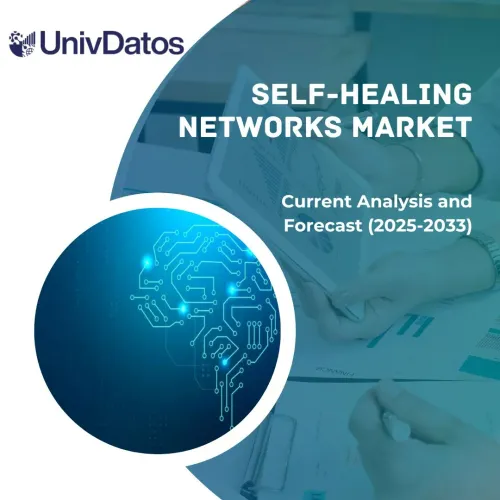- Home
- About Us
- Industry
- Services
- Reading
- Contact Us
Data Center Liquid Cooling Market: Current Analysis and Forecast (2025-2033)
Emphasis on Component {Solutions, (Indirect Liquid Cooling, Direct Liquid Cooling), Services (Design and Consulting, Installation and Deployment, Support and Maintenance)}; Size (Small and Mid-Sized Data Centers, Large Data Centers); Type (Hyperscale data centers, Enterprise data centers, Colocation data centers, and Others); End-Use Industry (IT and Telecom, Banking, Financial Services, and Insurance (BFSI), Media and Entertainment, Healthcare, Government and Defence, Retail, Others); and Region/Country
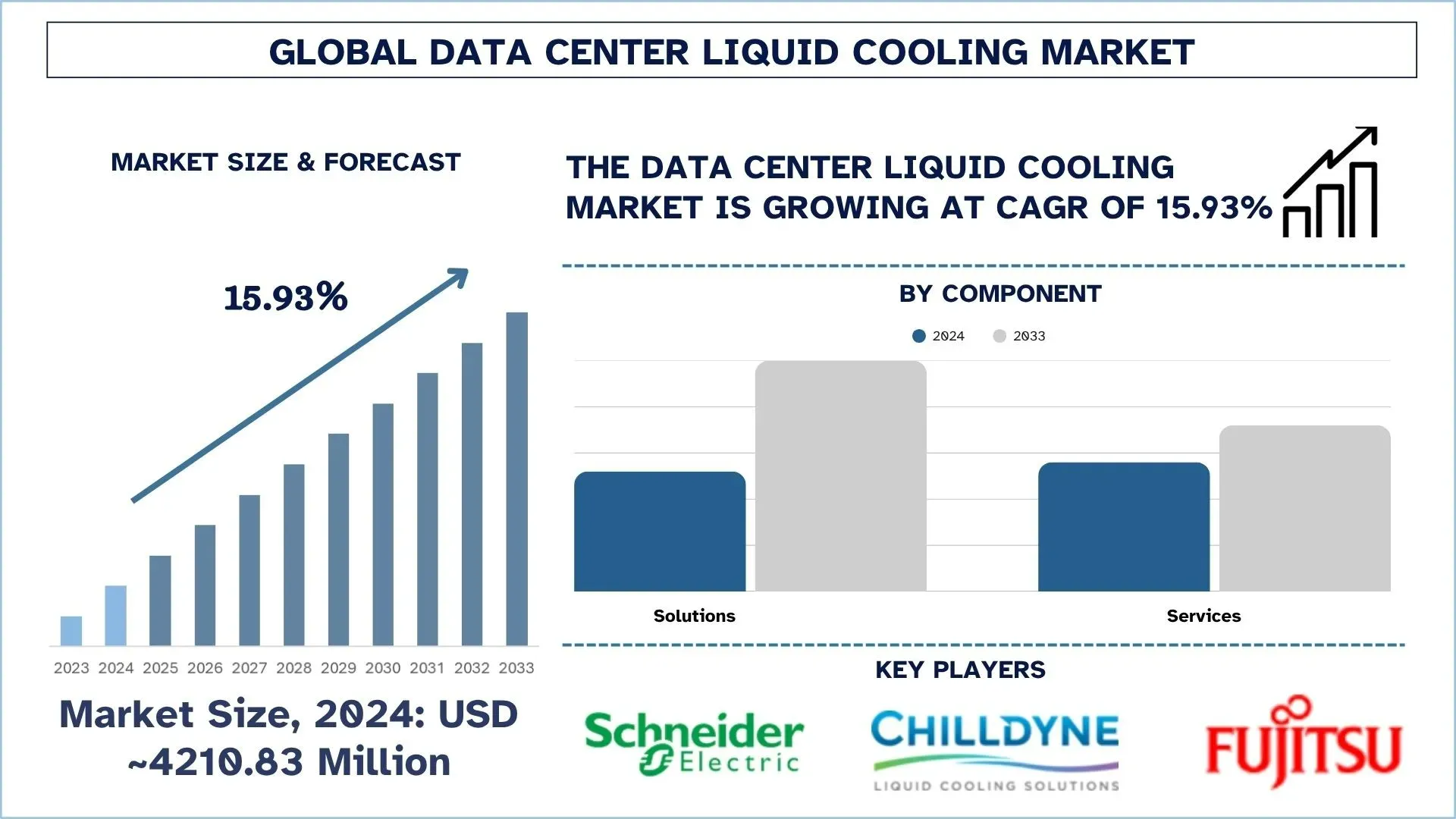
Global Data Center Liquid Cooling Market Size & Forecast
The Global Data Center Liquid Cooling Market was valued at USD 4210.83 Million in 2024 and is expected to grow to a strong CAGR of around 15.93% during the forecast period (2025-2033F), owing to the rising AI’s computational power, standard regulations by the organizations, and addressing power constraints globally.
The global data center liquid cooling solutions market is experiencing dynamic growth with the increasing demand for high-performance computing, AI, and big data analytics. Traditional air cooling is no longer efficient as data centers expand, driving more efficient liquid cooling solutions. Some of the solutions, such as direct-to-chip and immersion cooling, offer superior thermal management, enabling higher server densities and reducing energy consumption. The necessity for energy efficiency, environmental legislation, and the use of edge computing and cloud services are driving growth in the global data center liquid cooling solution market. Further, the market is expected to expand as data centers pivot to satisfy the demands of real-time computing as well. In fact, Delta launched its Core Shell Liquid-Cooled Busbar and HVDC Air-Cooled Busbar on May 21, 2025, which is capable of up to 50VDC/8000A and 800VDC/1000A, which will provide consistent operation of the systems. Furthermore, in areas with more advanced liquid cooling, Delta’s liquid-to-liquid cooling systems can provide cooling upwards of 1,500 kW. In addition, Delta has also introduced rack-level coolant distribution units with up to 200kW of cooling and the ability to deliver liquid-cooled cold plates for GPUs and CPUs to provide excellent thermal support for next-generation chips.
Global Data Center Liquid Cooling Market Trends
This section discusses the key market trends that are influencing the various segments of the global Data center liquid cooling market, as found by our team of research experts.
Increased Demand for Hybrid Simulation
The augmenting trend of hybrid simulation in data centers is catalyzing the growth of the global data center liquid cooling market robustly. Hybrid simulation combines air and liquid cooling technologies, allowing data centers to effectively handle fluctuating thermal loads related to high-performance computing (HPC) applications like artificial intelligence (AI) and machine learning. Since these applications involve high-density computing, conventional air-cooling techniques usually prove inadequate, and thus, liquid cooling technologies are employed. Moreover, the adoption of hybrid cooling infrastructure is gaining traction as data centers can achieve a higher power usage effectiveness (PUE) ratio, representing improved energy efficiency. In total, growing demand for hybrid simulation for data centers is fueling the expansion of the global data center liquid cooling market.
Data Center Liquid Cooling Industry Segmentation
This section provides an analysis of the key trends in each segment of the global Data center liquid cooling market report, along with forecasts at the global, regional, and country levels for 2025-2033.
Liquid Cooling Solutions dominates the Data center liquid cooling Market.
Based on Component, the market is bifurcated into solutions and services. Solutions are further segmented into indirect liquid cooling and direct liquid cooling markets, while services are further segmented into design and consulting, installation and deployment, and support and maintenance. Solutions are dominating the market and drastically changing the data center operations by dealing with heat generated from high-density computing applications economically. Compared to traditional air cooling, DLC applies liquid-based systems for cooling and dissipating heat from the most dependable and performance-driven components directly. This predominantly reduces energy consumption, decreases the cost of operations, and imposes minimal environmental impacts. Artificial intelligence and machine learning applications with high compute intensity accelerated the development of DLC technologies further. For instance, On January 16, 2024, Aligned Data Centers, announced the launch of its DeltaFlow~ TM liquid cooling technology a patent-pending solution designed to support the high-density compute requirements of next-generation applications and high-performance computing (HPC), including artificial intelligence (AI), machine learning (ML), and supercomputers.
The Large Data Center dominates the Data Center Liquid Cooling Market.
Based on the size, the market is segmented into small and mid-sized data centers and large data centers. The large data centers segment dominated the market in the historic year as they can meet the demand for localized, scalable, and inexpensive computing power. Not only have IoT (Internet of Things) devices grown exponentially, but the expanding reality of applications related to advanced technologies such as artificial intelligence (AI) and 5G has expanded the number of data points related to processing data in real time. On the other hand, small and medium data centers can often be nearer to the data in their ecosystems, which the logistics of fulfilment and processing will facilitate the edge computing that can lead to a lower level of latency and improve operating efficiency in various industries (e.g. health care, telecommunications, manufacturing, etc.). The ability of modular and containerized designs to provide a fast and flexible infrastructure allows a business to scale and change based on future needs and changing requirements. Finally, the growing concerns around data protection and compliance are creating a push towards localized data as well.
North America is expected to grow at a considerable rate during the forecast period.
North America leads the data center liquid cooling industry, attributed to the presence of major tech giants and data center operators. There exist many hyperscale data centers in the U.S., operated by leading cloud service providers and tech biggies like Google, Amazon, and Microsoft. The rising demand for high-performance computing, with the growing use of AI and ML applications, gives rise to the need for advanced cooling solutions in the region. Moreover, a rise in stringent controls exists on energy efficiency and environmental sustainability that push for greater use of liquid cooling technologies in North American data centers. The market in this region is expected to grow at a good CAGR over the forecast period with the ongoing strategic investments through product launches, strategic mergers and acquisitions, collaborations, etc.
March 18, 2024: Schneider Electric, the leader in the digital transformation of energy management and automation, announced a collaboration with NVIDIA to optimize data center infrastructure and paved the way for groundbreaking advancements in edge artificial intelligence (AI) and digital twin technologies. Adding to this, special focus would be on enabling high-power distribution, liquid-cooling systems, and controls, designed to ensure simple commissioning and reliable operations for the extreme-density cluster.
On November 2, 2023, Vertiv introduced Vertiv™ SmartMod™ Max CW, a prefabricated modular data center designed to address the growing demand for rapid deployment of compute. This configurable and scalable solution supported up to 200kW of total IT load in a single system that utilized chilled water cooling for reduced environmental impact and energy efficiency and has been available in North America. For further growth, the companies in the region must embrace the advances in liquid cooling technologies, such as immersion and direct-to-chip, to keep pace with the rising AI and high-performance computing workloads.
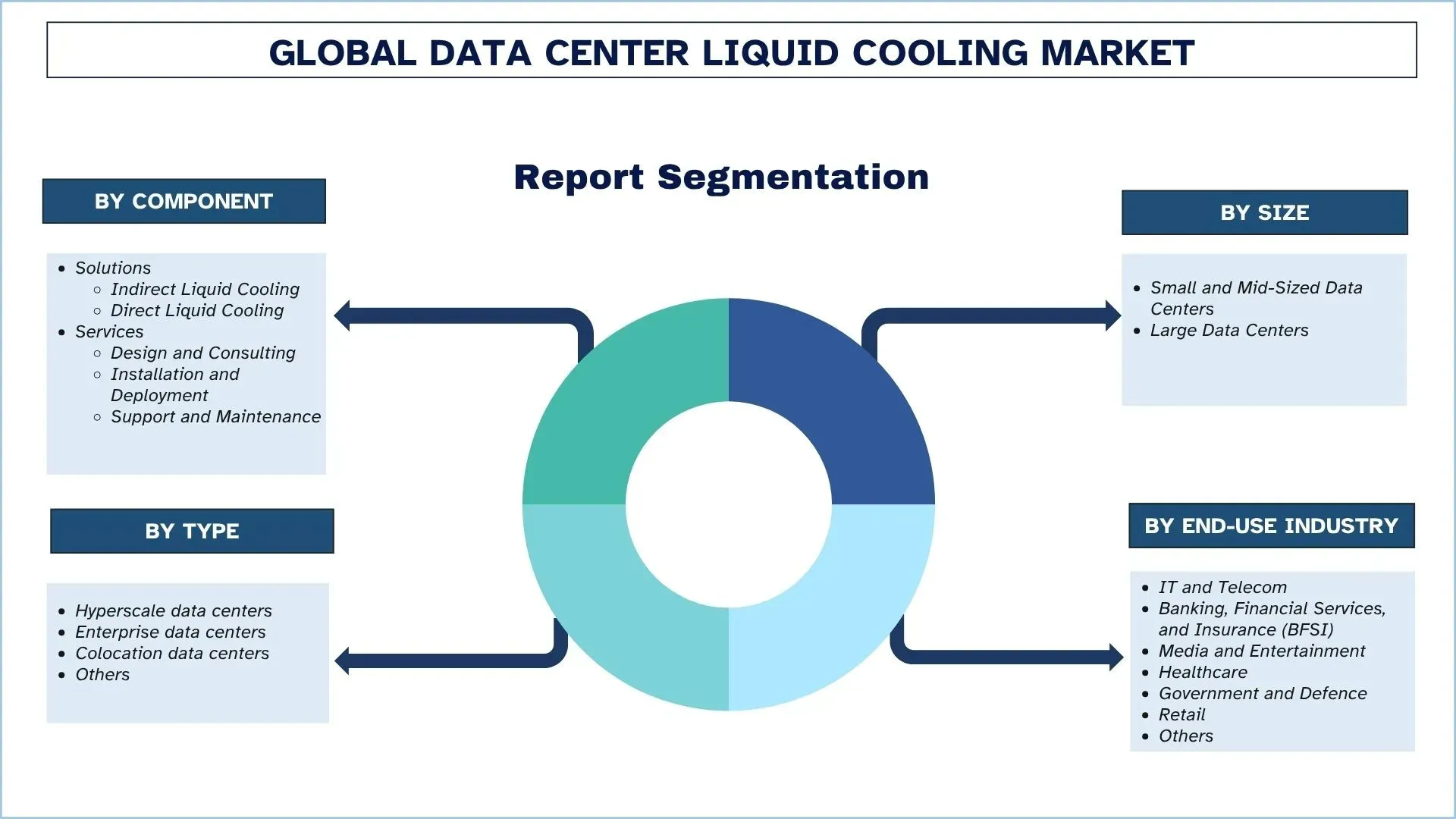
The U.S. held a dominant share of the North American Data Center Liquid Cooling market in 2024
The United States has a greater part of the world market for liquid cooling in data centers. At the same time, the benefits of hyperscale data centers and the need for high-performance computing led to the growth of this market. Further, grants and tax credits provided by the U.S. government support the implementation of highly advanced technologies, making it a data center innovation hub. Companies are aggressively accepting the advanced liquid cooling solutions for data centers to meet the burgeoning growth of high-performance computing and artificial intelligence workloads. Major tech giants such as Google, Microsoft, and Meta are also making use of complex cooling technologies like immersion and direct-to-chip solutions, which have the potential to absorb heat generated by AI workload and cloud services.
Schneider Electric, which is one of the global leaders in the digital transformation of energy management and automation, announced that it had an agreement to acquire a controlling interest in Motivair Corporation on October 17, 2024. Motivair Corporation is headquartered in North America and specializes in liquid cooling and advanced thermal management solutions for high-performance computing systems. Schneider Electric’s portfolio of direct-to-chip liquid cooling and high-capacity thermal solutions is expected to enhance its existing offerings and further innovation in cooling technology with this acquisition.
On October 03, 2024, Jabil Inc., which is one of the global leaders in design, manufacturing, and supply chain solutions, announced the completion of the acquisition of Mikros Technologies LLC. Mikros Technologies LLC is one of the pioneering leaders in the engineering and manufacturing of liquid cooling solutions for thermal management. Jabil Inc. would be able to help its customers manage the high thermal requirements of the current and next-generation products while keeping sustainability and cost considerations with the acquisition of Mikros Technologies LLC.
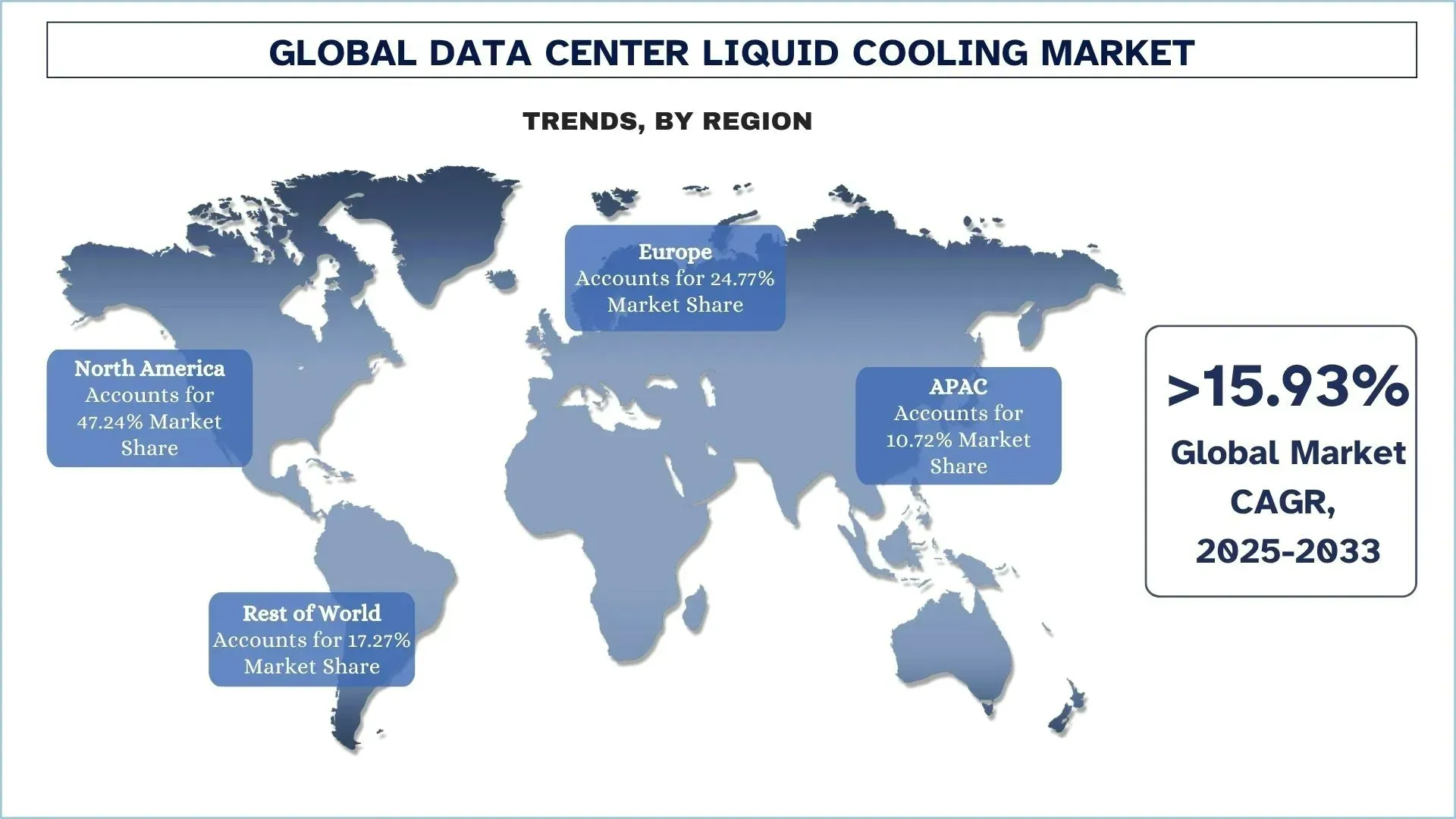
Data Center Liquid Cooling Industry Competitive Landscape
The global Data center liquid cooling market is competitive, with several global and international market players. The key players are adopting different growth strategies to enhance their market presence, such as partnerships, agreements, collaborations, new product launches, geographical expansions, and mergers and acquisitions.
Top Data Center Liquid Cooling Companies
Some of the major players in the market are Schneider Electric, AQ Compute Services Germany GmbH (Aquila Group); Asetek Inc. A/S (Asetek A/S); RITTAL GmbH & Co. KG (Friedhelm Loh Group); Vertiv Group Corp. (Vertiv Holdings Co.); Green Revolution Cooling, Inc.; Chilldyne, Inc.; FUJITSU (Furukawa Group); DCX INC; Submer.
Recent Developments in the Data Center Liquid Cooling Market
On May 15, 2025, Flex declared the acquisition of JetCool Technologies, which specializes in providing liquid cooling solutions for data centers and high-performance computing. This strategic acquisition would further expand Flex’s capabilities in confronting the issues of power, heat, and scalability challenges of hyperscale and enterprise data centers that are deployed with AI workloads.
On October 17, 2024, Schneider Electric announced plans to buy a controlling stake in Motivair Corp, a specialist in liquid cooling for high-performance computing of about USD 850 million, for growing data centres.
On May 20, 2024, Investment firm King Street Capital Management announced that it had acquired a majority ownership stake in the Silicon Valley colocation provider named Colovore, a liquid-cooled data center operator in California.
Global Data Center Liquid Cooling Market Report Coverage
Report Attribute | Details |
Base year | 2024 |
Forecast period | 2025-2033 |
Growth momentum | Accelerate at a CAGR of 15.93% |
Market size 2024 | USD 4210.83 Million |
Regional analysis | North America, Europe, APAC, Rest of the World |
Major contributing region | North America is expected to dominate the market during the forecast period. |
Key countries covered | U.S., Canada, Germany, France, U.K., Italy, Netherlands, China, Japan, India, and Australia |
Companies profiled | Schneider Electric; AQ Compute Services Germany GmbH (Aquila Group); Asetek Inc. A/S (Asetek A/S); RITTAL GmbH & Co. KG (Friedhelm Loh Group); Vertiv Group Corp. (Vertiv Holdings Co.); Green Revolution Cooling, Inc.; Chilldyne, Inc.; FUJITSU (Furukawa Group); DCX INC; Submer |
Report Scope | Market Trends, Drivers, and Restraints; Revenue Estimation and Forecast; Segmentation Analysis; Demand and Supply Side Analysis; Competitive Landscape; Company Profiling |
Segments Covered | By Component, By Size, By Type; By End-Use Industry; By Region/Country |
Reasons to Buy the Data Center Liquid Cooling Market Report:
The study includes market sizing and forecasting analysis confirmed by authenticated key industry experts.
The report briefly reviews overall industry performance at a glance.
The report covers an in-depth analysis of prominent industry peers, primarily focusing on key business financials, type portfolios, expansion strategies, and recent developments.
Detailed examination of drivers, restraints, key trends, and opportunities prevailing in the industry.
The study comprehensively covers the market across different segments.
Deep dive regional-level analysis of the industry.
Customization Options:
The global data center liquid cooling market can further be customized as per the requirements or any other market segment. Besides this, UnivDatos understands that you may have your own business needs; hence, feel free to contact us to get a report that completely suits your requirements.
Table of Content
Research Methodology for the Global Data Center Liquid Cooling Market Analysis (2025-2033)
We analyzed the historical market, estimated the current market, and forecasted the future market of the global data center liquid cooling market to assess its application in major regions worldwide. We conducted exhaustive secondary research to gather historical market data and estimate the current market size. To validate these insights, we carefully reviewed numerous findings and assumptions. Additionally, we conducted in-depth primary interviews with industry experts across the data center liquid cooling value chain. After validating market figures through these interviews, we used both top-down and bottom-up approaches to forecast the overall market size. We then employed market breakdown and data triangulation methods to estimate and analyze the market size of industry segments and sub-segments.
Market Engineering
We employed the data triangulation technique to finalize the overall market estimation and derive precise statistical numbers for each segment and sub-segment of the global Data center liquid cooling market. We split the data into several segments and sub-segments by analyzing various parameters and trends, including component, size, type, end-use industry, and regions within the global Data center liquid cooling market.
The Main Objective of the Global Data Center Liquid Cooling Market Study
The study identifies current and future trends in the global data center liquid cooling market, providing strategic insights for investors. It highlights regional market attractiveness, enabling industry participants to tap into untapped markets and gain a first-mover advantage. Other quantitative goals of the studies include:
Market Size Analysis: Assess the current and forecast market size of the global data center liquid cooling market and its segments in terms of value (USD).
Data center liquid cooling Market Segmentation: Segments in the study include areas of component, size, type, end-use industry, and regions.
Regulatory Framework & Value Chain Analysis: Examine the regulatory framework, value chain, customer behavior, and competitive landscape of the data center liquid cooling industry.
Regional Analysis: Conduct a detailed regional analysis for key areas such as Asia Pacific, Europe, North America, and the Rest of the World.
Company Profiles & Growth Strategies: Company profiles of the data center liquid cooling market and the growth strategies adopted by the market players to sustain in the fast-growing market.
Frequently Asked Questions FAQs
Q1: What is the global data center liquid cooling market’s current market size and growth potential?
The global data center liquid cooling market was valued at USD 4210.83 Million in 2024 and is expected to grow at a CAGR of 15.93% during the forecast period (2025-2033).
Q2: Which segment has the largest share of the global data center liquid cooling market by Component?
The solutions segment is dominating the market and drastically changing the data center operations by dealing with heat generated from high-density computing applications economically. Compared to traditional air cooling, DLC applies liquid-based systems for cooling and dissipating heat from the most dependable and performance-driven components directly.
Q3: What are the driving factors for the growth of the global data center liquid cooling market?
The rising AI’s computational power, standards regulation by the organizations, and addressing the power constraints globally are some of the factors driving the global data center liquid cooling market.
Q4: What are the emerging technologies and trends in the global data center liquid cooling market?
Increased demand for hybrid simulation and integration of AI and Machine Learning are the emerging trends shaping the industry’s future.
Q5: What are the key challenges in the global data center liquid cooling market?
High initial costs and technical complexities are some of the key challenges faced by the data center liquid cooling market.
Q6: Which region dominates the global data center liquid cooling market?
North America leads the data center liquid cooling industry, attributed to the presence of major tech giants and data center operators. There exist many hyperscale data centers in the U.S., operated by leading cloud service providers and tech biggies like Google, Amazon, and Microsoft.
Q7: Who are the key players in the global data center liquid cooling market?
Some of the key companies in the global data center liquid cooling market are:
• Schneider Electric
• AQ Compute Services Germany GmbH (Aquila Group)
• Asetek Inc. A/S (Asetek A/S)
• RITTAL GmbH & Co. KG (Friedhelm Loh Group)
• Vertiv Group Corp. (Vertiv Holdings Co.)
• Green Revolution Cooling, Inc.
• Chilldyne, Inc.
• FUJITSU (Furukawa Group)
• DCX INC
• Submer
Q8: What are the investment opportunities in the data center liquid cooling market?
The data center liquid cooling market presents compelling investment opportunities driven by the escalating demand for energy-efficient and sustainable infrastructure. Key areas for investment include advanced cooling technologies such as immersion and direct-to-chip systems, which are essential for managing the high heat loads associated with AI and high-performance computing workloads.
Q9: How are regulations affecting the data center liquid cooling market?
Regulations are significantly influencing the adoption of liquid cooling technologies in data centers by enforcing stricter energy efficiency and environmental standards. For instance, California's Title 24 energy code penalizes air-cooled data centers exceeding a Power Usage Effectiveness (PUE) of 1.15 during peak hours, prompting operators to retrofit with liquid cooling systems to comply with these regulations.
Related Reports
Customers who bought this item also bought



